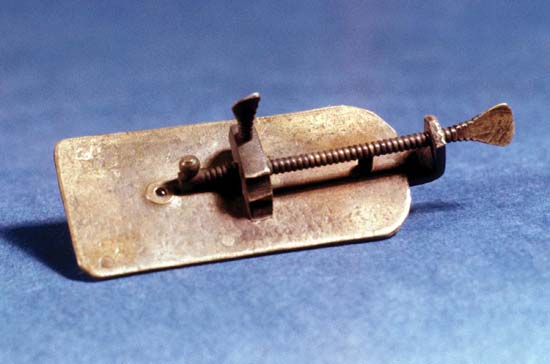Historical records of the magnifying glass are harder to come by than records of coexisting magnification technologies. Some of the first optical tools besides the magnifying glass were spectacles and microscopes, which exploited optics for a specific purpose.
The spectacle may very well be considered as a form of magnifying glass, utilizing a frame to hold a lens in place to increase the magnification of the eyes. Amati is traditionally credited with the invention of the spectacle in 1280 in Florence, although it is uncertain. This followed Bacon’s utilization of glass spheres as magnifiers in 1267. By the sixteenth century, the idea of holding a lens a certain distance from the eye in order to produce a magnified image was well developed and began to manifest itself in optical instruments.
The earliest description of an optical instrument, specifically a telescope, was by Leonard Diggs in a 1571 edition of Pantometria:
Marvellous are the conclusions that may be performed by glasses concave and convex of circular and parabolicall formes. By these kinds of glasses, or rather frames of them, placed in due angles, yee may not onely set out the proportion of an whole region… ye shall discerne any trifle or reade any letter lying there open,… as plainly as if you were corporally present, although it be distante from you as farre as the eye can decrie.
One of the first conceptions of a multi-lens magnification system was by Francastoro of Verona in his Homocentrica of 1535, detailing the use of multiple lenses to further increase magnification properties. By 1590, it is probable that compound microscopes had been developed. Their invention has been credited to Zacharias Janssen. The compound microscope “gradually acquired fashionability” (Ford 19), and a flurry of interest in microscopy followed the publishing of Robert Hooke’s Micrographia in 1665.
Antony van Leeuwenhoek, unknown and untrained in the world of optics, developed a single lens microscope by the late 1600s which had better resolving power than that of compound microscopes. New and interesting specimens placed greater demands on the microscopes of the 1600s, and by the 1700s microscopy was propelled forward by the invention of new optical tools.
 A single-lens microscope of Antony van Leeuwenhoek
A single-lens microscope of Antony van Leeuwenhoek
The capacity of microscopy was augmented by the invention of new magnification techniques. Technologies such as the polarizing light microscope, reflected light microscope, optical microscope, and electron microscope have allowed for increased magnification and new visualizations of specimens.
Nonetheless, the magnifying glass has remained a constant throughout the history of optical instruments. It is not an antiquated instrument but has remained in use for hundreds of years, remaining constant yet also expanding into new forms and functions. As the magnifying glass has changed throughout history, it has undoubtedly been affected by the technologies briefly acknowledged here. The question which these technologies raise is why the magnifying glass has persisted.
Back to The Basics of the Magnifying Glass
Posted at Dec 05/2008 04:18PM:
chris witmore: Great work. I like your point that while the magnifying glass is a constant, the proliferation of these other instruments mediated the roles it came to fill. This connects back to your interest in the situated use of the magnifying glass.
